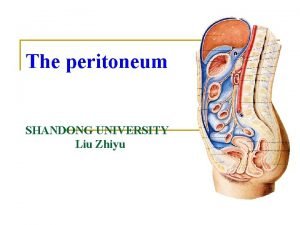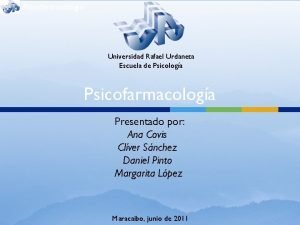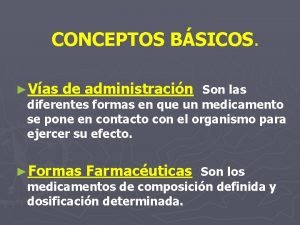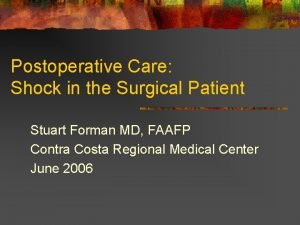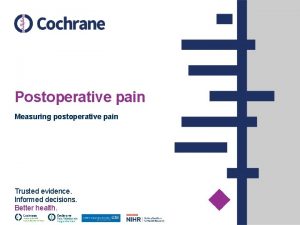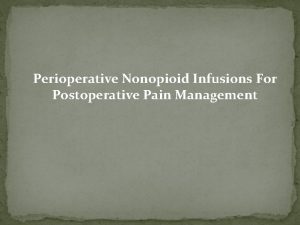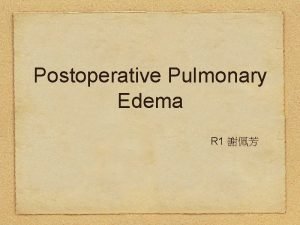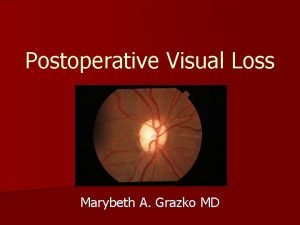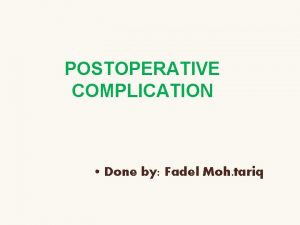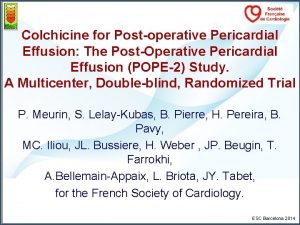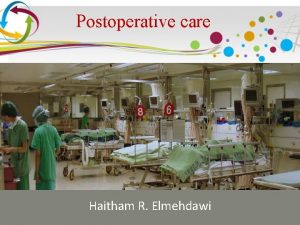INTRAARTICULAR AND INTRAPERITONEAL OPIOIDS FOR POSTOPERATIVE PAIN A
























- Slides: 24


INTRA-ARTICULAR AND INTRAPERITONEAL OPIOIDS FOR POSTOPERATIVE PAIN A. Hamid_ zokaei , Fellowship of cardiac anesthesia. Kermanshah University of Medical Sciences. (k. u. m. s. )

INTRA-ARTICULAR OPIOIDS


• The use of arthroscopic techniques in orthopedic surgery has gained a preeminent role as diagnostic and therapeutic procedures for the knee, hip, ankle, shoulder, and hand. • Arthroscopy is typically an outpatient procedure, and although touted as being less painful than open surgical procedures, is nevertheless associated with postoperative pain that is at times severe. • Oral and systemic analgesics, including opioids and nonsteroidal anti-inflammatory drugs (NSAIDs), have been used with varying degrees of success to combat postoperative pain, but with various attendant side effects also reported.


• The intra-articular (IA) injection of local anesthetics and adjuvants has been considered efficacious in modulating postoperative pain, but support for their routine use is limited. • Recently, in Europe, there has been a trend toward using large volumes of diluted local anesthetics and adjuvants intra-articularly for managing acute pain associated with major knee joint replacement surgery.

• Mu-agonist opioids, most notably morphine, have support for use in moderate to severe pain when administered IA, but whether the resultant analgesia is due to a local or systemic effect is debatable. • NSAIDs have consistently demonstrated a benefit in modulating postoperative pain when injected IA, yet there is a concern that they may inhibit or retard bone healing.

• The use of the alpha-2 agonist clonidine IA has demonstrated a modest and limited reduction in postoperative pain, although the same controversy exists as to whether these benefits are mediated systemically or are local phenomena. • Other agents, such as ketamine, corticosteroids, and neostigmine, are currently undergoing IA trials but current support for their use is sparse.

INTRA-ARTICULAR MORPHINE

• Morphine is the prototypical µ-receptor opioid agonist to which all other opioids are compared. • IA morphine, in some studies, has been shown to provide improved analgesia after knee arthroscopy when compared to local anesthetic alone or to saline placebo. • IA morphine may be more beneficial for use in “high inflammatory” arthroscopic knee surgery (e. g. , anterior cruciate ligament reconstruction, lateral release, patellar shaving, and plicae removal) than for use in “low-inflammatory” surgery (knee arthroscopy for meniscectomy).

• Catheter-IA morphine (4 mg) in combination with ropivacaine (90 mg) and ketorolac (30 mg) provided superior analgesia and reductions in morphine use in a group of patients undergoing Bankart procedures who administered ropivacaine using PCRA versus patients treated with placebo regimens.

• IA morphine has not shown promising results after shoulder arthroscopy or total knee arthroplasty, and its use following ankle arthroscopy remains to be defined. • There is clinical evidence that supports the use of IA morphine given preemptively, for pain occurring following certain types of knee manipulation, including arthroscopic surgery, while there is conflicting evidence in support of the use of IA morphine for major reconstructive procedures.

INTRA-ARTICULAR MEPERIDINE, FENTANYL AND SUFENTANIL

• Meperidine is a synthetic opioid agonist at µ- and k-opioid receptors derived from phenylepiperidine. • Meperidine has been injected IA in doses of 10 to 200 mg, alone or in combination with local anesthetics and tenoxicam. • The use of IA meperidine resulted in lower VAS pain scores at rest but not during movement. • When IA or intramuscular meperidine (10 mg) was compared to morphine (1 mg) or fentanyl (10 micro) for knee arthroscopy, no difference between the groups was noted although there was a tendency for improved analgesia in the IA meperidine group.

• Fentanyl is a phenylpiperidine derivative synthetic opioid agonist that is structurally related to meperidine. • As an analgesic, fentanyl is about 75 to 100 times more potent than morphine. • A single dose of fentanyl administered intravenously has a more rapid onset than morphine and a shorter duration of clinical effect, although the elimination half-life is longer than that of morphine.

• It might be expected that sufentanil would provide results similar to those of fentanyl when used IA since sufentanil is a thienyl analog of fentanyl. • Sufentanil has a greater affinity for opioid receptors than fentanyl, and is about 12 times as potent. • IA fentanyl analgesia in doses up to 100 µg or sufentanil up to 10 µg both appear to be modestly successful in modulating nociception after knee arthroscopy. • IA fentanyl, sufentanil, and meperidine have less support for use following arthroscopic surgery than does the use of IA morphine.

INTRA-ARTICULAR TRAMADOL

• Tramadol is a synthetic narcotic with a weak µ-receptor agonist activity. • It also enhances the function of the spinal descending inhibitory pathway by inhibition of reuptake of both 5 -hydroxytryptamine (5 -HT) and norepinephrine and stimulate the presynaptic release of 5 -HT. • IA tramadol 100 mg appears to have analgesic effects after knee arthroscopies and medial meniscectomies.

INTRAPERITONEAL OPIOIDS

• Unlike the studies on IA opioids where several clinical studies were performed, there is little clinical evidence supporting the use of opioid analgesics via the intraperitoneal(IP) route. • IP opioids have been studied following laparoscopic gynecologic surgery, laparoscopic cholecystectomy, and open intra-abdominal procedures.

• There is some suggestion that IP meperidine plus bupivacaine is beneficial following laparoscopic cholecystectomy and gynecologic surgery, although this is an evolving area of scientific study associated with some controversy. • The IP administration of morphine has not been demonstrated in human studies to exert a beneficial effect following laparoscopic surgery.


 Opioids for neuropathic pain
Opioids for neuropathic pain Mydriatics and miotics drugs
Mydriatics and miotics drugs Pain x mad
Pain x mad Tender nipples sign of early pregnancy
Tender nipples sign of early pregnancy Stomach ligaments
Stomach ligaments Lig teres hepatis
Lig teres hepatis Peritoneum
Peritoneum Functions of peritoneum
Functions of peritoneum Abdominal tutorial
Abdominal tutorial Inyección intraperitoneal
Inyección intraperitoneal Vía intramuscular
Vía intramuscular Intertubercular plane
Intertubercular plane Parietal peritoneum visceral peritoneum
Parietal peritoneum visceral peritoneum Nursing care of cataract
Nursing care of cataract Preoperative checklist definition
Preoperative checklist definition Is pregnancy pain same as period pain
Is pregnancy pain same as period pain Data klinis adalah
Data klinis adalah Postoperative shock
Postoperative shock Fspos vägledning för kontinuitetshantering
Fspos vägledning för kontinuitetshantering Typiska drag för en novell
Typiska drag för en novell Tack för att ni lyssnade bild
Tack för att ni lyssnade bild Ekologiskt fotavtryck
Ekologiskt fotavtryck Varför kallas perioden 1918-1939 för mellankrigstiden?
Varför kallas perioden 1918-1939 för mellankrigstiden? En lathund för arbete med kontinuitetshantering
En lathund för arbete med kontinuitetshantering Särskild löneskatt för pensionskostnader
Särskild löneskatt för pensionskostnader




